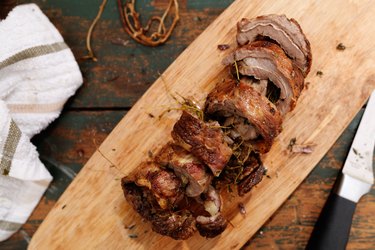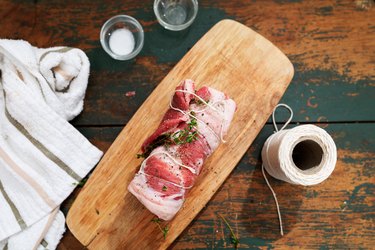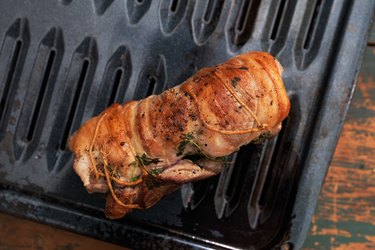
Slow cooking your lamb flaps is a good way to take this tough cut of meat and transform it.
Although lamb is usually pricier type of meat, a few often-overlooked cuts still offer good value. One is lamb flaps, known more formally as breast of lamb. It's the portion of the animal's chest that contains the gristly ends of the ribs, trimmed away when the butcher cuts racks and rib chops.
The meat is relatively tough for lamb and is interleaved with thick bands of fat. Traditionally, it's deboned, stuffed and rolled, then roasted so much of the fat can render and drip away. Here's the best way to cook lamb flaps.
Video of the Day
Video of the Day
Things You'll Need
Sharp knife
Salt and pepper, or other seasonings
Stuffing (optional)
Butcher's twine
Cutting board
Roasting pan with rack
Serving tray
Step 1: Preparing Your Lamb Flaps

First, debone, trim, season, roll and tie off your lamb flaps to prepare them for cooking.
- Examine your flaps to see if they are bone-in or boneless.
- If they still contain the ends of the ribs, you'll need to remove them: Slide a thin, sharp knife under the flat layer of bones and gristle. Trim them away with long, smooth strokes of the knife, keeping it angled toward the bone to minimize waste.
- Trim away any thick layers of fat at either the inside or outside surface. If you're patient, you can minimize the fat further by carefully separating the layers of fat and lean meat, then stacking the meat layers back together. Leave at least 1/4 inch of fat on the outside to keep the meat from drying out too much as it cooks.
- Season the meat inside and out with salt and pepper, or any other seasonings and fresh herbs you desire. If you wish, you can stuff the inside with your favorite bread or whole-grain mixture.
- Roll the deboned flaps on your cutting board, shaping them into one or more tight cylinders.
- Tie them with butcher's twine so they maintain their compact shape as they cook.
Related Reading
Step 2: Cooking Your Lamb Flaps

Always make sure you cook you lamb flaps sufficiently to avoid food poisoning.
- Preheat your oven (or grill) to 325 degrees Fahrenheit.
- Heat a large skillet over medium-high heat and sear the tightly-rolled lamb flaps until they're browned on all sides.
- Place your flaps on the rack of a roasting pan and slide it into the oven. If you're using a grill, turn off one of your burners. Place the lamb there, so it won't cause flare-ups as the fat drips out.
- Slow-roast the lamb in your oven or grill until the stuffing in the middle reaches a temperature of 160 degrees Fahrenheit, approximately 2 to 2 1/2 hours. The tough muscles and connective tissues will soften during the slow cooking, giving the lamb a rich and tender texture.
- Remove the lamb to a serving tray and let it rest for 5 to 10 minutes before slicing the string and serving.
Related Reading
Tips for Cooking Lamb Flaps
- If you're grilling the lamb flaps, place a shallow pan under the roast to catch the dripping fat and prevent it from ruining your barbecue.
- In the United States, lamb flaps are sometimes marketed as lamb belly, to capitalize on the popularity of equally-fatty pork belly.
- Instead of the slow-roasting, low-fat technique described here, leave most of the fat in place and roast the flaps in a hot oven or grill at 400 to 425 degrees Fahrenheit. The meat will be chewier but have a rich and savory flavor from the hot cooking.
- Alternatively, braise the lamb breast slowly in broth and red wine. Like slow-cooked Asian pork belly, it'll be superlatively rich and flavorful.